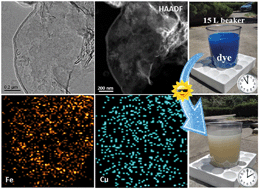Ultrathin g-C3N4 nanosheets coupled with amorphous Cu-doped FeOOH nanoclusters as 2D/0D heterogeneous catalysts for water remediation†
Abstract
The construction of heterogeneous catalysts with high efficiency is important for the degradation of organic pollutants. Catalysts with small cluster dispersions are thus highly desirable to maximize the amount of active sites and enhance the atom efficiency. Here, a simple and scalable method was designed to fabricate amorphous sub-nanometer Cu-doped FeOOH clusters/ultrathin g-C3N4 nanosheet (Cu-FeOOH/CNNS) hybrids as heterogeneous photo-Fenton catalysts. The fabricated hybrids possess a unique hierarchical nanostructure, comprising abundant uniformly dispersed ultrafine Cu-FeOOH clusters tightly anchored on the CNNS surface. The optimal loading content of Cu-FeOOH clusters decolorized ∼98.7% methylene blue (MB) within 40 min in a wide pH value range of 4.8–10.1, which is more than 8.1 times faster than pristine CNNS. Moreover, influential factors, including the initial MB concentration, H2O2 concentration, initial pH and multiform organic contaminants, such as azo dyes, nitrophenol and antibiotics, were investigated and analyzed in detail. The degradation efficiency remained the same even after 10 cycles, suggesting the robustness and stability of the fabricated hybrids. The excellent degradation efficiency is attributed to the cluster active sites and the synergistic activation of Fe/Cu/CNNS promoting the generation of ˙OH for MB degradation. A practical application of water remediation on a 15 L scale was also performed with expected MB degradation efficiency under the coexisting dyes. The fabricated hybrid is expected for practical industrialization applications and this design and fabrication strategy provided a generic route for further design of catalysts with high activities for PFR.

- This article is part of the themed collection: Best Papers 2018 – Environmental Science: Nano


 Please wait while we load your content...
Please wait while we load your content...